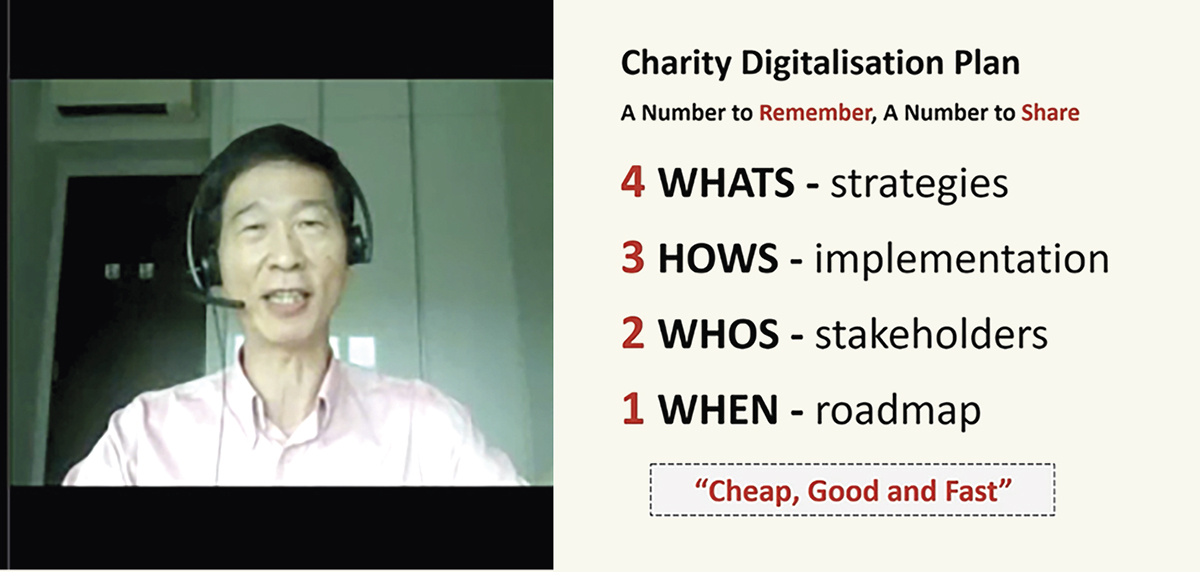4-3-2-1 Charity Digitalisation Plan

SHARED SUCCESS THROUGH SHARED STRATEGIES
Charities play a crucial role in society by meeting needs, coordinating efforts and ensuring that no one is left behind. The importance of charities has been brought to the fore during the Covid-19 pandemic as there is greater urgency to ensure that vulnerable groups are supported.
Covid-19 has also made the charity operating landscape challenging. The viability and sustainability of charities are impacted due to a fall in donations and volunteers that are needed to run important programmes and services. However, there are opportunities in uncertainty. Looking at Covid-19 and beyond, there is strong impetus for charities to become more digital. By embracing digitalisation, charities can attain operational efficiency as well as improve service delivery. For example, a charity would be able to engage more volunteers and expand donor outreach through virtual volunteering and online fund-raising platforms.
Furthermore, the time is right for charities to adopt a digitalisation strategy. With the government, the people and the community pushing forward in digitalisation, the charity sector needs to ride on this opportunity:
- From the government’s standpoint, there has been a push to help charities embrace digitalisation. An example of this is the Invictus Fund that was set up to maintain service continuity, retain staff and adopt technology.
- From the people’s standpoint, there are many families making fuller use of technology to facilitate home-based learning, business meetings and even having meals together. With people becoming more open to technology, the charity sector should tap on this as avenues to connect with the public.
- Finally, from the community’s standpoint, there are also multiple ground-up groups coming together to help and encourage everyone during this period. With the government, people and the community embracing technology, the timing is right for the charity sector to digitise as well.
While the reasons to digitalise are compelling, the ways to achieve this might not be clear. If a bottom-up approach is taken, each charity will go off on its own and procure digital assets and systems, working in silos and eventually making little progress as there is no communication and no synergy. On the other hand, if a top-down approach is taken, where the government enforces alignment, charities might lose a sense of ownership of their process.
Therefore, the way to digitalise the charity sector is one of balance and coordination. It is a shared journey where both the charities and Commissioner of Charities (COC) work closely together to co-create strategies to achieve digitalisation in a cheap, good and fast manner. On June 23, I shared about a “4-3-2-1 Charity Digitalisation Plan” during the Conversation with COC event (Figure 1). This plan focuses to help charities digitise through “4” strategies, “3” implementation modes, “2” stakeholders and “1” roadmap.
Figure 1 Dr Ang sharing the “4-3-2-1 Charity Digitalisation Plan” during a Conversation with COC event
4 STRATEGIES
There are four shared strategies that can be adopted to digitally transform the sector. These strategies are structured like a pyramid, which requires more sharing with every additional layer (Figure 2). These strategies also have a multiplier effect where the sector benefits even more with each layer. It starts with “Shared Resources”, followed by “Shared Packages”, “Shared Data” and finally, “Shared Solutions”.
Figure 2 Four shared strategies
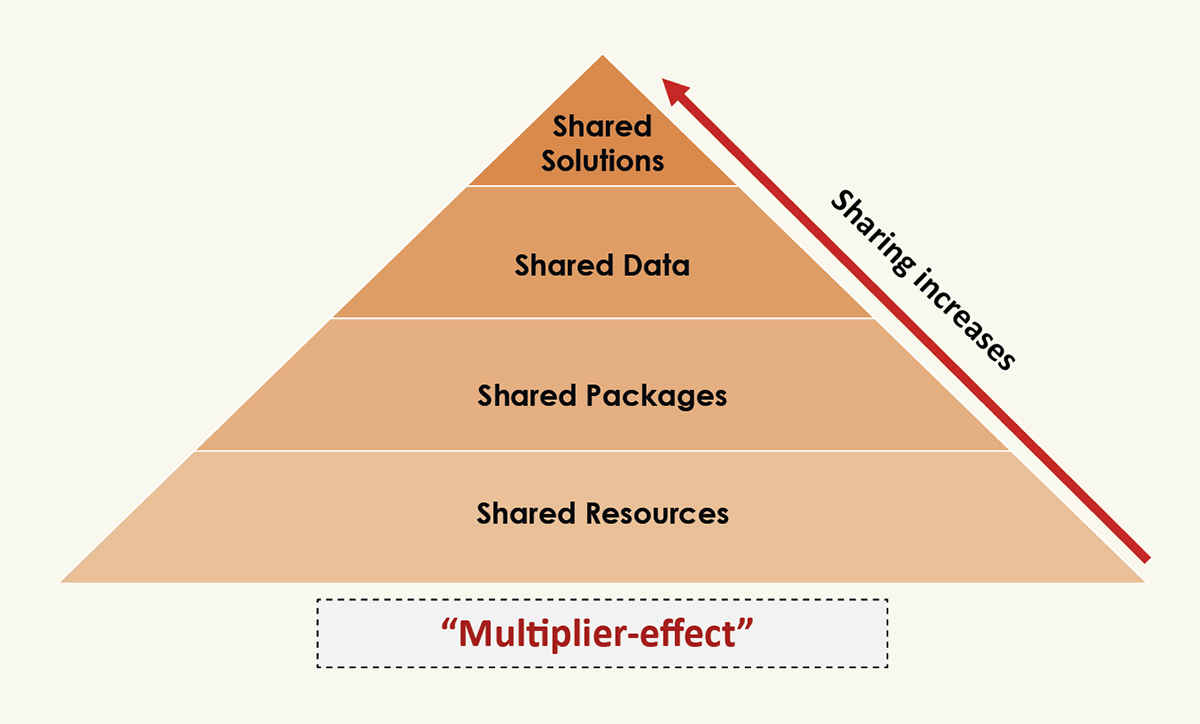
Shared Resources
The strategy of “Shared Resources” is about helping charities to expand volunteer and donor reach without building anything new. This strategy encourages charities to tap on open and shared platforms such as Give.Asia, Ray of Hope, Simply Giving and Giving.sg to reach out to donors and spread their messages. This is beneficial as charities would be able to tap on the wide and established network of well-known platforms. Furthermore, these platforms have signed the community of practice with COC. This subjects them to adhere to the Code of Practice and hence, provides the assurance of safe giving.
Another example for “Shared Resources” is the use of the SG Cares app. This app is designed to be the personalised and convenient tool for the public to show care. By posting opportunities on the SG Cares app, individuals would be able to see giving opportunities, become a volunteer or make donations with just a few clicks.
Shared Packages
The “Shared Packages” strategy seeks to help charities to reduce cost and improve operational efficiency by leveraging on standard corporate packages. As these packages are done through a pre-approved vendor, there is also strengthened governance due to good internal controls and quality assurance.
COC has signed a Memorandum of Understanding (MOU) with iShine Cloud Limited as one of the shared services partners to provide simple and affordable solutions to charities. The solutions include human resources (HR), accounting, donor management and volunteer management functions. In addition to these functions, iShine Cloud also provides support for charities through a helpdesk and cybersecurity monitoring and protection. This serves as a possible one-stop package for charities to meet corporate functional needs and hence improve internal capabilities.
Shared Data
The “Shared Data” strategy is crucial in ensuring that everyone has good awareness of the current needs and efforts. This will help to reduce the gap between over-served and under-served segments of society, thereby reducing market failure.
For example, during this Covid-19 pandemic, there was an urgent need to provide food and essential aid to vulnerable groups. Given that food is a perishable resource, tight coordination among charities was necessary. To achieve this, charities and community groups coordinated with a government agency to reduce the gap between over-served and under-served beneficiaries. Being mindful that the handling and sharing of data must comply with data protection regulations, COC will formulate a set of shared data guidelines for charities so that data-sharing can be kept simple, effective and coordinated.
Shared Solutions
The “Shared Solutions” strategy seeks to increase collaboration and effectively manage services. This can only be achieved through good case management where charities fully understand the journey of customers, and carefully plan the various services and programmes to provide the best possible service. This involves having a deep understanding of challenges and needs, and working with other charities to identify services and programmes to provide the support and help needed.
The importance of shared solutions can be explained with a hypothetical but realistic situation. Imagine that an elderly woman has just been discharged from a hospital due to a minor stroke. What kind of assistance do you think she needs? First, we need to meet her physical needs by providing a medical escort. Second, we need to meet her basic needs by providing her with healthy meals through meal-delivery services. Third, we need to meet her emotional needs through befriending services to ensure that she is adapting well to her new lifestyle. Fourth, we need to provide for her medical needs by arranging for her to go for physiotherapy, and ensuring that she has enough medication. Finally, to facilitate quick and sustained recovery, we also need to involve her in social groups to encourage an active lifestyle.
With so many different charities and services required, it is only logical for charities to coordinate efforts and work on cases together, perhaps through a centralised case management system.
All four strategies can be employed only if charities focus on combined scale and tap on synergies, so that solutions can be built once and be used by many. However, this begs the next big question – How can we implement these strategies?
3 IMPLEMENTATION MODES
Akin to shared strategies, implementation should be balanced between a top-down and bottom-up approach. For bottom-up, there is a need for people to be digitally ready, and for top-down, there is a need for a structure to direct the sector. It is also important to have a bridge between bottom-up and top-down approaches by having a process which enables charities that want to digitally transform. Therefore, through people, process and structure, three gaps can be bridged – an expertise gap, a resource gap and a gap created by silos (Figure 3).
Figure 3 Bridging three gaps
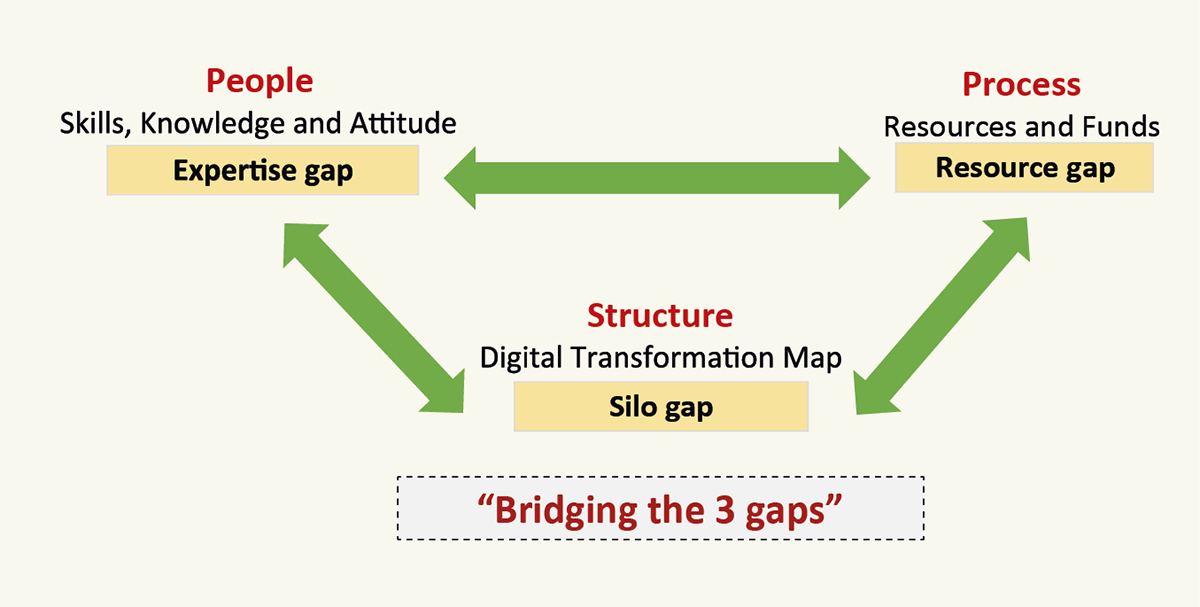
People form the backbone of the charity sector. Therefore, it is important to invest in people and increase their skills, knowledge and attitude through training and to ensure that they embrace digital readiness. There is a need for people to change from “I don’t know” to “I know”, and “I don’t want” to “I want”.
In addition to people, there is also a need for process to enable all charities who are willing to transform to be given the resources to do so. For example, charities can tap on the enhanced VCF Info-Communications Technology Grant to gain access to digital resources.
Finally, there is a need for structure to provide alignment and focus, so that charities know both the direction and the steps needed to digitally transform. This refers to having a digitalisation transformation map for charities across the key sectors that provides a clear articulation of what the charity sector will look like through digitalisation.
2 STAKEHOLDERS
The 4 shared strategies and 3 implementation areas need the help and efforts of 2 key stakeholders. These stakeholders can be classified as “I” and “we”.
Figure 4 Key stakeholders
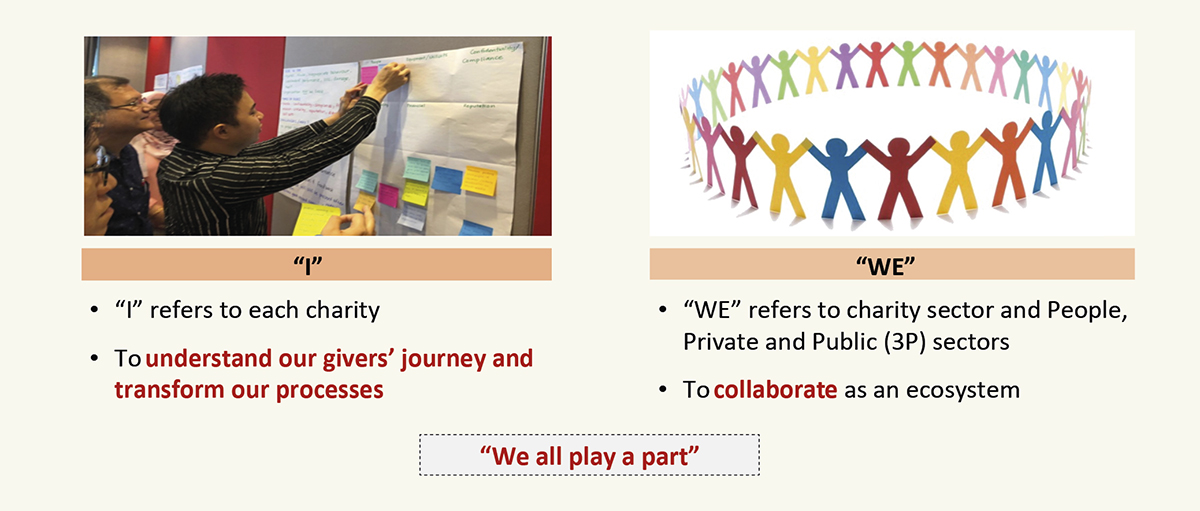
“I” refers to each charity. Every charity plays an important role in understanding the needs of vulnerable groups and coming up with programmes and services to ensure help and support is given. As each charity strives to ensure that no one is left behind, there is a need for each charity to adopt a growth and digital mindset.
However, just having a digital mindset is not enough. Digital transformation requires the commitment to change and the determination to pursue it. To digitally transform, there is a need to objectively look at processes and challenge the status quo. One good way to do this is by understanding the journey of donors and volunteers. By understanding their journeys, charities can change operational processes and business models to maximise engagement to provide a positive giving experience. This will lead to sustainable efforts as these givers will see themselves as stakeholders in the charity and will want to keep giving and even become multipliers where they ask others to give as well.
“We” refers to the whole community – both the charity sector and the people, and the private and public sectors. Only through collaboration can the sector meet the complex needs of vulnerable groups and provide them with the care and support needed. To collaborate, there is a need for a strong and deeply-rooted network. This comes in the form of the SG Cares Community Networks that help to coordinate among many different community stakeholders so that information can be shared, and solutions can be co-created. The Volunteer Centres can also serve as nodes within a town to facilitate and champion the digitalisation process of charities
Beyond the charity sector, there is a need for more private sector collaborations to provide the infrastructure and resources for charities to tap on, to become more digital. This can possibly be done by tapping on the spare capacity of corporations. As it takes the whole community to produce a digital and effective charity sector, we are left with one more big question – What can be done now?
1 ROADMAP
We can be ready to digitally transform by following a roadmap to convert vision into action (Figure 5). This roadmap seeks to provide comprehensive recommendations, alignment in actions across different sectors, and collective responsiveness for all charities to work together, and through this, attain superior performance for all charities.
Figure 5 One Charity Digitalistion Roadmap
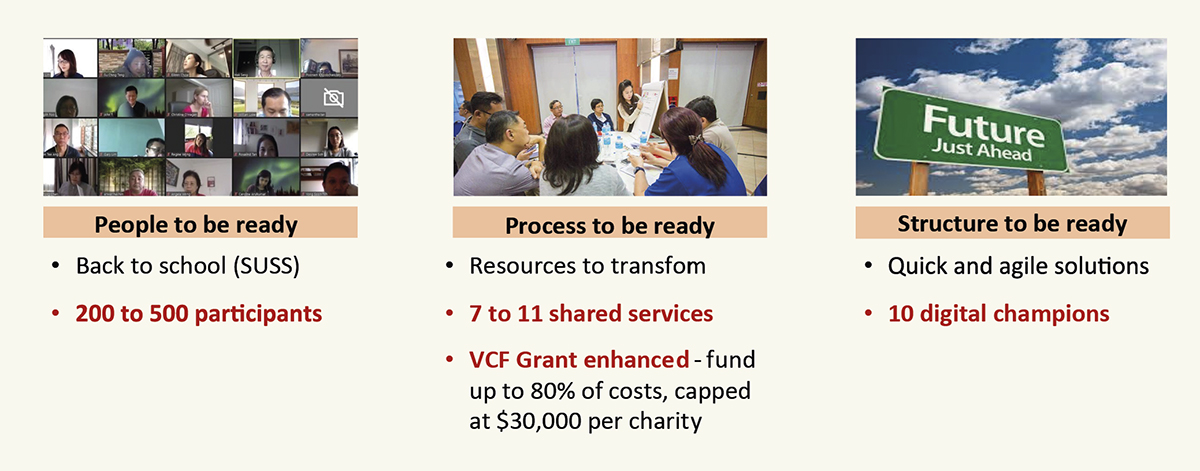
Firstly, we want the people to be ready by helping charity and staff go back to school. COC is partnering with Singapore University of Social Sciences to provide a certification course in High Performing Charities. This course seeks to equip charities with the skills to engage in business transformation. There are currently about 200 participants from charities who have attended the course. Moving forward, the aim is to have 500 charity participants attend this course.
In light of the changes brought about by the Covid-19 pandemic, COC is also working with other partners to develop webinars to help charities adapt. Such webinars (Figure 6) include topics like extraordinary annual general meeting, financial resilience and online fundraising. Thus far, about 1,000 participants have attended the courses online. If you wish to view these webinars, please refer to the various QR codes in Figure 7.
Figure 6 Dr Ang presenting at a webinar on the impact of Covid-19 legislation on charities
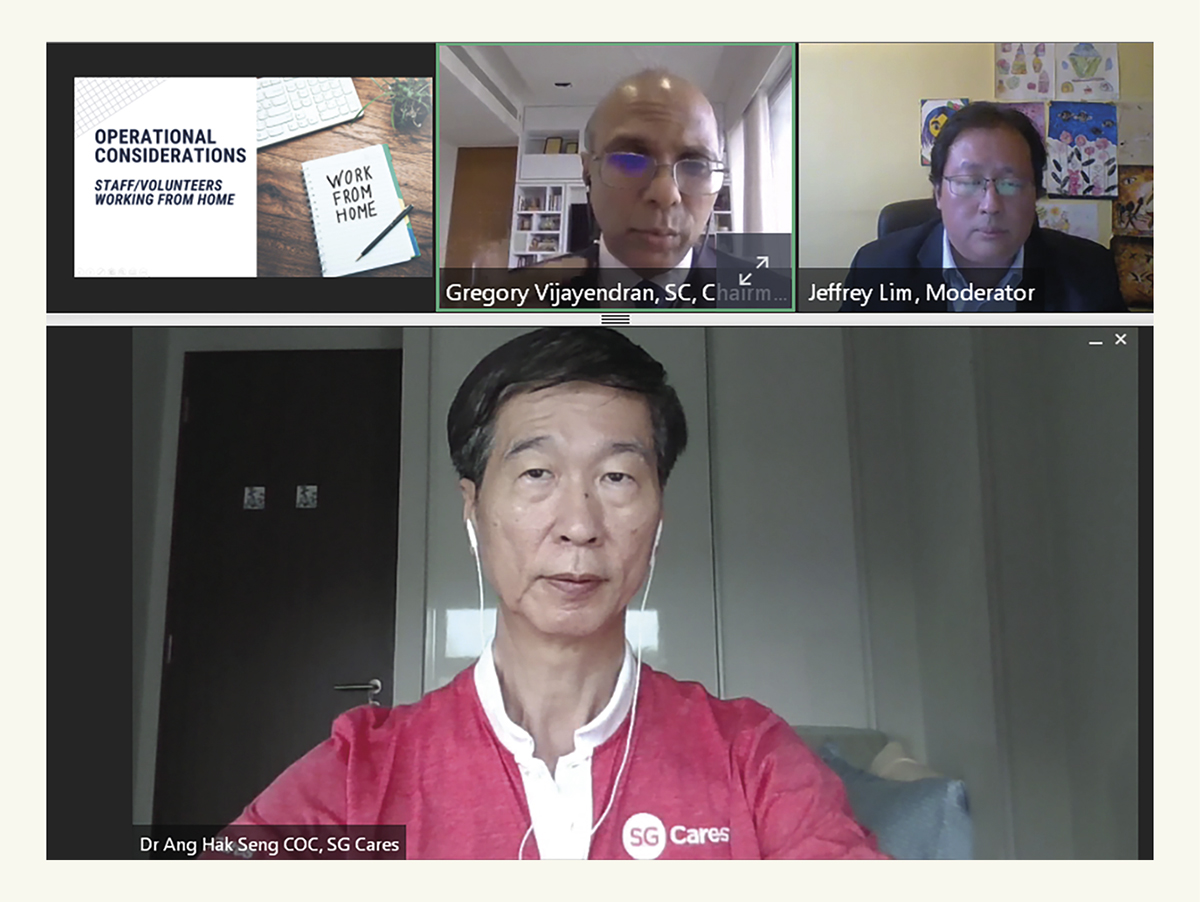
Figure 7 List of QR codes for webinars

Secondly, we want processes to be ready so that charities will have the resources to transform. The VCF Info-Communications Technology Grant will be enhanced to provide charities with more support in adopting digital solutions. The Grant will fund up to 80% of costs, capped at $30,000 per charity. We are also increasing the number of our shared services partners from seven to 11. This touches on a wide range of services from corporate matters like HR to business matters like process re-engineering.
Finally, we want to have a structure to facilitate quick and agile solutions. For this, we will work with 10 charities to be digital champions in the sector. These digital champions should cover a wide range of different charities of different scale and causes to conduct rapid prototyping. Through these champions, we will then scale up efforts to the whole sector.
CONCLUSION
The path to digitalisation is not easy. But using this 4-3-2-1 framework, charities can think big, start small and act fast so that the sector can seize opportunities for digitalisation.
The COC will walk this journey with all charities. We will support you, work with you and listen to you – and together, we will emerge stronger.
Dr Ang Hak Seng, FCA (Singapore), is Deputy Secretary (Singapore Cares), Ministry of Culture, Community and Youth; Commissioner of Charities, and Adjunct Professor, Nanyang Technological University.
This article was first published by The Institute of Singapore Chartered Accountants in the ISCA Journal, August 2020. The original article can be read by clicking here.

